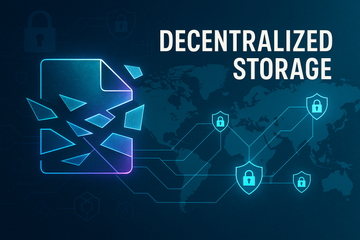You’ve probably heard it all before: the cloud’s secure, convenient, and always there…until it isn’t. We live in a hyper-connected, click-and-store culture where digital files—photos, contracts, entire fortunes—float somewhere “out there.” But who really owns them? Who controls access? And what happens when that trusted company loses your trust? Enter decentralized storage—a movement that’s quietly transforming how we protect our digital stories.
Wait, What’s Decentralized Storage All About?
Let’s skip the jargon for a moment. Imagine you want to stash your treasure. Would you pick one vault, trusting it never to fail, or would you break it into pieces, spread across countless vaults worldwide, each guarded independently? That’s the basic promise of decentralized storage. Your files aren’t huddled in one server farm in Silicon Valley—they’re scattered, encrypted, and resilient.
Instead of handing over your data to massive players like Google, Dropbox, or Amazon, you’re leveraging a peer-to-peer network run by people, not monoliths. Individual users around the globe offer up spare hard drive space, creating a digital patchwork quilt—your files live as small, encrypted fragments, each managed securely and transparently. Only you, the data owner, have the keys to piece the puzzle back together.
Why Does It Matter? (It’s Not Just About Paranoia)
Sure, the appeal to privacy buffs and crypto diehards is obvious, but honestly, decentralized storage isn’t about hiding in digital shadows. It’s about control. Recent headlines—leaked data, random outages, lost memories—prove that a single point of failure, both technical and political, isn’t always the wisest vault.
In decentralized systems, if one node goes offline, your data is safe. If a government requests data deletion, there’s no one company to pressure. It’s like having a failsafe baked into the system. Your story can’t be altered or erased by anyone else. That kind of peace of mind? Pretty powerful.
Let’s Get Technical (But Not Boring)
Here’s the thing: decentralized storage isn’t just about scattering files. It’s about cryptographic wizardry and trustless design.
- Encryption and sharding: Files are carved into many shreds, heavily encrypted, and sent across the network. Even a rogue operator can’t unscramble them without your key.
- Redundancy: Multiple copies exist on different nodes, so if one fails, another rises to the challenge. Imagine never losing a photo again due to a glitchy hard drive.
- Blockchain backbone: Many networks use blockchain to log where each file piece lives, confirm integrity, and even settle payments with participants.
Projects like Filecoin, Storj, and Sia are building robust ecosystems around this idea. And let’s not forget, companies like Trezor and Ledger—household names for anyone serious about crypto—encourage pairing hardware wallets with decentralized storage for safeguarding keys, private documents, or even NFTs.
Crypto Enthusiasts, Heads Up!
Now, if you’re a crypto veteran, you might wonder, does decentralized storage pose risks? Here’s where things get interesting. When paired with hardware wallets—think the beloved Trezor or Ledger—you essentially split your trust between two ultra-resilient guardians: one protects your digital keys, the other protects your data. Your assets can be as decentralized as your files. It’s a little like locking your valuables in a vault, then hiding the vault’s blueprints across the globe.
What about the average person? Maybe you’re not holding a fortune in Bitcoin, but you’re tired of hack after hack and feeling like you’re always a step behind digital disasters. Decentralized storage offers a chance to regain genuine control—no more helplessly watching the news, hoping you’re not affected this time.
Who’s Really Using This—and Why?
You know what? The early adopters are everywhere, often motivated by real events. Artists, journalists, activists, and even corporate teams looking for censorship-resistance, bulletproof backups, or just more affordable storage have started turning to decentralized options. Recent reports from sites like The Block and DeStor show that crypto communities are pushing adoption hard. Mainstream users aren’t far behind, especially as user interfaces improve and integration with tools like Trezor or Ledger becomes more seamless.
Artists sometimes use decentralized storage to ensure their work can’t be deleted or censored by platforms with shifting rules. Journalists in restrictive regions use these platforms as lifelines when every word could face erasure. And yes, even small teams that can’t justify “enterprise cloud” pricing see real cost savings by sharing storage space across a crowd rather than renting it from giants. It’s about independence, with a side of savings.
Challenges? Sure, But Progress Never Stops
No system is perfect, honestly. Decentralized storage comes with a learning curve. Configuring keys or navigating multiple nodes isn’t always as straightforward as clicking a big blue “Upload” button. Networks must incentivize strangers not only to participate, but to stick around—often by rewarding them with tokens or crypto. Compatibility with traditional apps can lag, and troubleshooting sometimes feels…well, more like an adventure than a quick fix.
But let’s be real: the same was said about personal computers, mobile phones, and the entire blockchain movement. Adoption starts niche, then snowballs. As the tech matures and privacy demands grow, decentralized alternatives will only become more inviting—even for those folks who never thought about digital sovereignty until one day, they needed it.
So, Is It Worth the Switch?
If you cherish privacy, independence, and resilience? Decentralized storage deserves a second look. Maybe not for every vacation selfie (though, why not?). But for anything you genuinely don’t want lost or controlled by someone else, it’s the digital equivalent of keeping your valuables just out of reach—protected, private, and honestly, pretty ingenious. As the crypto community leads the charge, and hardware wallet heavyweights like Trezor and Ledger cement the connection, it’s becoming easier and safer to embrace this new way to own your place on the internet.
Times are changing, and maybe, just maybe, it’s time we all took back the keys to our digital kingdoms. What do you think? Are you ready to trade a little convenience for a lot more control?











